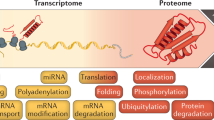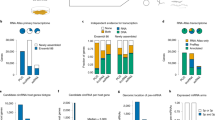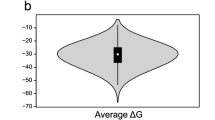Abstract
Faced with the avalanche of genomic sequences and data on messenger RNA expression, biological scientists are confronting a frightening prospect: piles of information but only flakes of knowledge. How can the thousands of sequences being determined and deposited, and the thousands of expression profiles being generated by the new array methods, be synthesized into useful knowledge? What form will this knowledge take? These are questions being addressed by scientists in the field known as ‘functional genomics’.
This is a preview of subscription content, access via your institution
Access options
Subscribe to this journal
Receive 51 print issues and online access
$199.00 per year
only $3.90 per issue
Buy this article
- Purchase on SpringerLink
- Instant access to full article PDF
Prices may be subject to local taxes which are calculated during checkout


Similar content being viewed by others
References
Altschul, S. F. et al. Gapped BLAST and PSI-BLAST: a new generation of protein database search programs. Nucleic Acids Res. 25, 3389–3402 (1997).
The C. elegans Sequencing Consortium. Genome sequence of the nematode C. elegans: a platform for investigating biology . Science 282, 2012–2018 (1998).
Chervitz, S. A. et al. Comparison of the complete protein sets of worm and yeast: orthology and divergence. Science 282, 2022 –2028 (1998).
Tatusov, R. L., Galperin, M. Y., Natale, D. A. & Koonin, E. V. The COG database: a tool for genome-scale analysis of protein functions and evolution. Nucleic Acids Res. 28, 33– 36 (2000).
Uetz, P. et al. A comprehensive analysis of protein–protein interactions in Saccharomyces cerevisiae. Nature 403, 623–627 (2000).
Ito, T. et al. Toward a protein-protein interaction map of the budding yeast: a comprehensive system to examine two-hybrid interactions in all possible combinations between the yeast proteins. Proc. Natl Acad. Sci. USA 97, 1143–1147 ( 2000).
Alizadeh, A. A. et al. Distinct types of diffuse large B-cell lymphoma identified by gene expression profiling. Nature 403, 503–511 (2000).
Lashkari, D. A. et al. Yeast microarrays for genome wide parallel genetic and gene expression analysis. Proc. Natl Acad. Sci. USA 94, 13057–13062 (1997).
Brown, P. O. & Botstein, D. Exploring the new world of the genome with DNA microarrays. Nature Genet. 21, 33–37 (1999).
Eisen, M. B., Spellman, P. T., Brown, P. O. & Botstein, D. Cluster analysis and display of genome-wide expression patterns. Proc. Natl Acad. Sci. USA 95, 14863– 14868 (1998).
Marcotte, E. M., Pellegrini, M., Thompson, M. J., Yeates, T. O. & Eisenberg, D. A combined algorithm for genome-wide prediction of protein function. Nature 402, 83–86 (1999).
Marcotte, E. M. et al. Detecting protein function and protein-protein interactions from genome sequences. Science 285, 751– 753 (1999).
Dandekar, T., Snel, B., Huynen, M. & Bork, P. Conservation of gene order: a fingerprint of proteins that physically interact. Trends Biochem. Sci. 23, 324–328 (1998).
Overbeek, R., Fonstein, M., D'Souza, M., Pusch, G. D. & Maltsev, N. The use of gene clusters to infer functional coupling. Proc. Natl Acad. Sci. USA 96, 2896–2901 (1999).
Enright, A. J., Iliopoulos, I., Kyrpides, N. C. & Ouzounis, C. A. Protein interaction maps for complete genomes based on gene fusion events . Nature 402, 86–90 (1999).
Pellegrini, M., Marcotte, E. M., Thompson, M. J., Eisenberg, D. & Yeates, T. O. Assigning protein functions by comparative genome analysis: protein phylogenetic profiles. Proc. Natl Acad. Sci. USA 96, 4285–4288 (1999).
Andrade, M. A. & Valencia, A. Automatic extraction of keywords from scientific text: application to the knowledge domain of protein families. Bioinformatics 14, 600– 607 (1998).
Kim, S. H. Structural genomics of microbes: an objective. Curr. Opin. Struct. Biol. (in the press).
Xenarios, I. et al. DIP: the Database of Interacting Proteins. Nucleic Acids Res. 28, 289–291 ( 2000).
Wickner, R. B. [URE3] as an altered URE2 protein: evidence for a prion analog in Saccharomyces cerevisiae. Science 264, 566– 569 (1994).
Bork, P. et al. Predicting function: from genes to genomes and back. J. Mol. Biol. 283, 707–725 (1998).
Huynen, M., Dandekar, T. & Bork, P. Differential genome analysis applied to the species-specific features of Helicobacter pylori. FEBS Lett. 426, 1–5 (1998).
Hegyi, H. & Gerstein, M. The relationship between protein structure and function: a comprehensive survey with application to the yeast genome. J. Mol. Biol. 288, 147– 164 (1999).
Ouzounis, C. & Kyrpides, N. The emergence of major cellular processes in evolution. FEBS Lett. 390, 119–123 (1996).
Gaasterland, T. & Ragan, M. A. Constructing multigenome views of whole microbial genomes. Microb. Comp. Genomics 3, 177–192 ( 1998).
Wu, Q. & Maniatis, T. A striking organization of a large family of human neural cadherin-like cell adhesion genes. Cell 97, 779–790 ( 1999).
Author information
Authors and Affiliations
Corresponding author
Rights and permissions
About this article
Cite this article
Eisenberg, D., Marcotte, E., Xenarios, I. et al. Protein function in the post-genomic era. Nature 405, 823–826 (2000). https://doi.org/10.1038/35015694
Issue Date:
DOI: https://doi.org/10.1038/35015694



